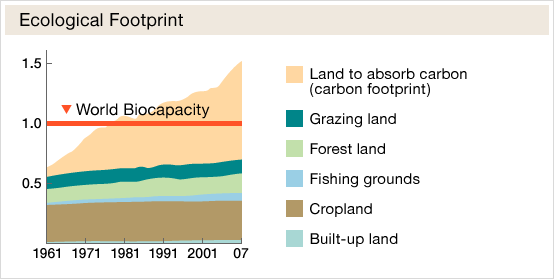Humans extract crops, water, timber, minerals and a variety of other resources from the Earth, then process and consume them, making our livelihoods and our economic activities possible. The waste (carbon dioxide and many other forms of waste) that comes from our lifestyles, our economy, and our society, is absorbed for us by the Earth (we cannot dispose of it in space!).
The Earth that supports the "sources" and "sinks" of our economic activities has not grown any larger since it was born 4.6 billion years ago. In other words, there is clearly a limit to its size. It is finite.
Our economic activities extract resources from this finite Earth, and, to the extent that the waste is being absorbed by the Earth, cannot grow forever. This is because the Earth's sources and sinks are also finite. If the economy expands, at some point it is inevitable that we will encounter the Earth's limits.
Over the past 50 years, the global economy grew by a factor of five. Accompanying that growth, world food production increased by a factor of about 2.5, the amount of water used by a factor of two, and the amount of timber logged for the production of pulp and paper increased by a factor of three.
Global demand for paper is rising steadily. What happens if the timber that serves as a raw material for paper (i.e., forests) does not grow at the same rate? The forests of the world will decline. And that is exactly what is happening today. What happens if groundwater is pumped up at a faster pace than the pace at which fallen rain permeates the ground and accumulates underground? Groundwater will be depleted, and no more will be available. And that is exactly what is happening around the world today.
The Earth is finite. Our economic activities can only continue to the extent that they are within the limits that can be supported by the Earth. Already, today, however, our economy is exceeding the limits that can be supported by the Earth. Even so, we are still trying to grow the economy.
There is a fascinating indicator called the "ecological footprint." It calculates the total land area required in order to provide resources such as the food, timber, fish, and urban land needed in the world, and to absorb the carbon dioxide emitted from human activities. If we compare this indicator to the amounts of land area that we are actually able to use, we can understand the relationship between what humanity is demanding of the Earth, and what the Earth is capable of providing.
At present, the resources of one-and-a-half Earths would be required to sustainably produce all of the resources required by humanity, and to absorb the carbon dioxide emitted by human activities. One Earth is not enough.

Source: WWF Japan (Living Planet Report)
It is not even sustainable to continue economic activities on the scale they are occurring now. No one can question the fact, therefore, that continued economic growth is not sustainable.
"I would accept the possibility of infinite growth in the economy on the day that one of my economist colleagues could demonstrate that Earth itself could grow at a commensurate rate."
Herman Daly (Former Senior Economist for the World Bank)





